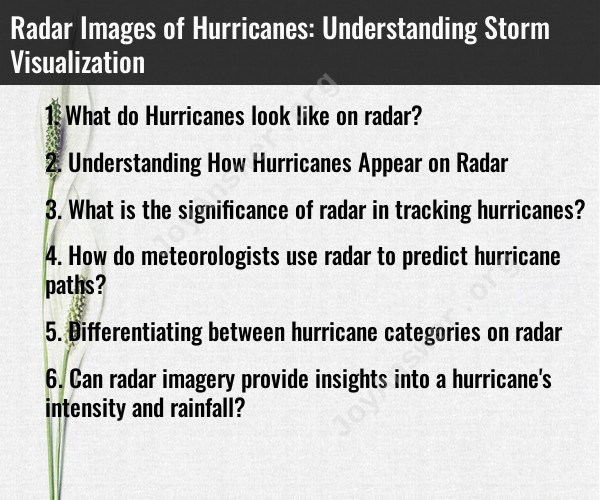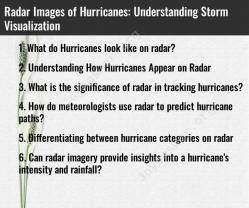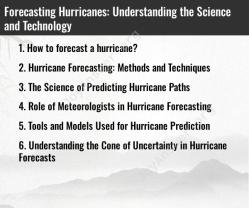What do Hurricanes look like on radar?
Hurricanes appear differently on radar images compared to how they are often depicted in satellite or visible imagery. Radar images provide valuable information about the structure and characteristics of hurricanes. Here's what hurricanes look like on radar:
Eye of the Hurricane:The eye of a hurricane appears as a well-defined, circular or elliptical region of calm and low precipitation on radar images. The eye is typically the center of the storm and is surrounded by the eyewall.
Eyewall:The eyewall is the region immediately surrounding the eye and is characterized by intense, often violent, convective activity. On radar, the eyewall appears as a ring of intense rainfall and thunderstorms. This is where the strongest winds and heaviest precipitation are typically found.
Rain Bands:Hurricanes have spiral-shaped rain bands that extend outward from the center. These bands can vary in intensity, with the outer bands often containing lighter rain. On radar, these rain bands appear as curving arcs or lines of precipitation. The outer bands are where you may find heavy rain and thunderstorms, but the most intense conditions are usually near the eyewall.
Doppler Radar Data:Doppler radar can provide additional information about the winds within the hurricane. By measuring the radial velocity of precipitation particles, Doppler radar can detect the wind patterns, including the rotation of the hurricane.
Dual-Polarization Radar:Some radar systems use dual-polarization technology, which can provide more detailed information about precipitation types and intensity. This technology helps meteorologists distinguish between rain, snow, hail, and other types of precipitation in the storm.
Debris and Tornado Signatures:In some cases, radar can detect debris signatures and tornadic activity within a hurricane. Tornadoes can occasionally form within the rain bands or in the outer regions of a hurricane. Radar can help identify these potential threats.
It's important to note that radar imagery is a crucial tool for tracking and monitoring hurricanes. Meteorologists use these images to understand the storm's structure, intensity, and movement. They help provide timely warnings and forecasts to protect people and property in the path of the hurricane. Radar data is complemented by satellite imagery, which provides a broader view of the hurricane's size and location within its environment. Together, radar and satellite data provide a comprehensive picture of a hurricane's behavior.
Understanding How Hurricanes Appear on Radar
Hurricanes appear on radar as areas of high reflectivity. This is because radar works by sending out pulses of radio waves and then measuring the strength and direction of the waves that bounce back. Water droplets and ice particles in the atmosphere reflect radio waves, so the stronger the reflection, the more water and ice there is in the air.
Radar imagery of hurricanes typically shows a central eye surrounded by a ring of high reflectivity. The eye is the calm center of the hurricane, where the winds are relatively light. The ring of high reflectivity is called the eyewall, and it is where the strongest winds and heaviest rainfall are found.
What is the significance of radar in tracking hurricanes?
Radar is essential for tracking hurricanes because it can provide meteorologists with real-time information about the storm's location, intensity, and size. This information is used to issue hurricane warnings and advisories, which help people to stay safe during hurricane season.
How do meteorologists use radar to predict hurricane paths?
Meteorologists use radar to predict hurricane paths by tracking the movement of the eyewall. The eyewall is typically located at the center of the hurricane's circulation, so tracking its movement gives meteorologists a good idea of where the storm is headed.
In addition to tracking the movement of the eyewall, meteorologists also use radar to identify changes in the storm's intensity. If the eyewall becomes more intense, it is a sign that the hurricane is strengthening. If the eyewall weakens, it is a sign that the hurricane is weakening.
Differentiating between hurricane categories on radar
Hurricane categories are based on the storm's maximum sustained wind speed. Category 1 hurricanes have sustained winds of 74-95 mph, while Category 5 hurricanes have sustained winds of 157 mph or higher.
Radar can be used to differentiate between hurricane categories by measuring the strength of the eyewall. The stronger the eyewall, the higher the hurricane category.
For example, a radar image of a Category 5 hurricane would show a very strong eyewall with a well-defined eye. A radar image of a Category 1 hurricane, on the other hand, would show a weaker eyewall and a less well-defined eye.
Can radar imagery provide insights into a hurricane's intensity and rainfall?
Yes, radar imagery can provide insights into a hurricane's intensity and rainfall. The strength of the eyewall is a good indicator of the hurricane's intensity. The size and intensity of the rainbands can also provide clues about the hurricane's rainfall potential.
For example, a hurricane with a strong eyewall and large, intense rainbands is likely to produce heavy rainfall. A hurricane with a weak eyewall and small, weak rainbands is likely to produce less rainfall.
Radar imagery can also be used to track the movement of rainbands. This information can be used to issue flash flood warnings for areas that are in the path of the rainbands.
Overall, radar is an essential tool for tracking and predicting hurricanes. It provides meteorologists with real-time information about the storm's location, intensity, size, and rainfall potential. This information is used to issue hurricane warnings and advisories, which help people to stay safe during hurricane season.



